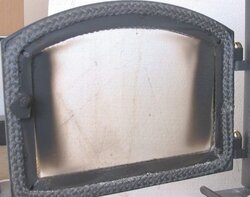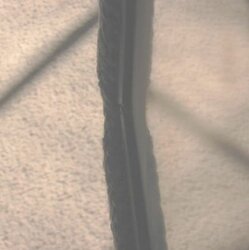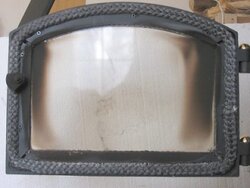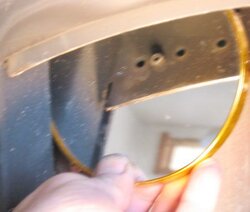Experience with woodstoves shows that, even with their sophisticated air systems, they are not overly complicated items, and if they're misbehaving, there's usually a reason (or reasons) why. I've decided to write this long-winded discourse as an encouragement to others who notice something not quite right with their stove's operation, and highlight some things to look out for in tracking down and solving the problems.
A few weeks ago I posted my dismay with how my new Quad 2100 was behaving. On paper this stove looked like it would give me everything I was wanting: consistent, controllable burns with front-to-back burn geometry; quick warmup; and a little larger firebox than the Morso. Well, what I got was indeed an effective heater, but one that had four significant faults that made it unacceptable to use.
1. One burn speed: hot and fast.
2. No useable coals for morning startup.
3. An uneven burn pattern in the firebox (always stronger, cleaner burn on the right and exiting to the left).
4. The glass becomes horribly crudded up in use. (See the first photo)
Now, I must say, I've never encountered a stove that both burned really hot AND dirtied up the glass so badly. Dirty glass usually points to a combustion issue of some sort. So from the start I had a hunch this was not going to be an easy one to tackle.
The dealer recommended I first check the door gasket; a leaky gasket could conceivably cause all of these problems. Sure enough, it was installed sloppily, leaving gaps and soft spots in three of the corners. See the second photo, showing the large gap in the lower right corner. So I replaced the gasket, being careful to maintain the density around the corners. Result: the glass became a little cleaner on the right, but even worse on the left side (see photo 3). So problems lay elsewhere.
At this point I knew that deeper scrutiny was required. So I took down the Quad and put the Morso back up to keep things warm. It was a nice reminder of just how sweet a stove the Morso is.
And so began a general inspection to discover anything that might be contributing to any of the stove's problems. First thing found was a gap, on the inside left, between the sheet that forms the airwash channel, about 3" high, 3/16" wide on the bottom, 1/16" on the top (see photo 4). There was no such gap on the right side. Sloppy construction. I patched it with stove cement.
I couldn't help but notice the holes in the panel that feeds the airwash channel. I've never seen this sort of thing before. This is a row of 14 holes 1/4" in diameter which goes all the way across (see photo 5). Quad is taking part of the air that would normally be the primary airwash air and dumping it directly into the exhaust stream above the firebox! No wonder the glass won't stay clean! And no wonder they can spec this stove at 2.1 gms/hr emissions! Except in high-fire conditions, the exhaust gasses are constantly being diluted by fresh air! It's one way they cheat to get the EPA figures lower.
OK, after seeing this, I decided it's time to examine each air system carefully. Despite it's name and the marketing hype surrounding it, the Quad 2100 has three air systems, a couple of which do double duty.
Primary air: Enters on the bottom-front (see photo 6). For this pic, the control is in "off" position. Notice the stop screw, welded in place. Even in the "off" position, the actual control is about 1/3 open. This opening feeds three sources: an "under-fire" air opening (lots more about this later), the primary airwash over the glass, and the row of holes mentioned above.
Secondary air: Two openings under the stove on either side, each 1"x2" (see photo 7). That's big. They feed the above-fire tubes and manifold with a HUGE amount of air. There is no control, they are always on.
Startup air: Is fed by a separate channel under the stove (see photo 8). Behind the bracket is a 2"x3" opening which feeds a hole in the bottom-rear of the firebox. When the control is opened (only when making a new fire or feeding new logs!) it gives tons of air to quickly fill the firebox with flames. Also notice the little hole there. I was very suspicious of it at first. Another 1/4" hole, a small amount of air is always being fed to the back of the fire, which really helps burn off the wood in the back of the firebox. Anyone who has used long, skinny stoves (front-to-back or north/south) knows that the very back of the logs are sometimes air-starved and don't always burn completely. The little amount of air that this opening gives makes sure it does. Very effective.
Well that is what we have to work with in solving this stove's problems. Part two will show what modifications were made and discuss the results.
EDIT: Ooops, only 4 pics per post allowed.... see this thread for the last four photos:
https://www.hearth.com/econtent/index.php/forums/viewthread/5430/
A few weeks ago I posted my dismay with how my new Quad 2100 was behaving. On paper this stove looked like it would give me everything I was wanting: consistent, controllable burns with front-to-back burn geometry; quick warmup; and a little larger firebox than the Morso. Well, what I got was indeed an effective heater, but one that had four significant faults that made it unacceptable to use.
1. One burn speed: hot and fast.
2. No useable coals for morning startup.
3. An uneven burn pattern in the firebox (always stronger, cleaner burn on the right and exiting to the left).
4. The glass becomes horribly crudded up in use. (See the first photo)
Now, I must say, I've never encountered a stove that both burned really hot AND dirtied up the glass so badly. Dirty glass usually points to a combustion issue of some sort. So from the start I had a hunch this was not going to be an easy one to tackle.
The dealer recommended I first check the door gasket; a leaky gasket could conceivably cause all of these problems. Sure enough, it was installed sloppily, leaving gaps and soft spots in three of the corners. See the second photo, showing the large gap in the lower right corner. So I replaced the gasket, being careful to maintain the density around the corners. Result: the glass became a little cleaner on the right, but even worse on the left side (see photo 3). So problems lay elsewhere.
At this point I knew that deeper scrutiny was required. So I took down the Quad and put the Morso back up to keep things warm. It was a nice reminder of just how sweet a stove the Morso is.
And so began a general inspection to discover anything that might be contributing to any of the stove's problems. First thing found was a gap, on the inside left, between the sheet that forms the airwash channel, about 3" high, 3/16" wide on the bottom, 1/16" on the top (see photo 4). There was no such gap on the right side. Sloppy construction. I patched it with stove cement.
I couldn't help but notice the holes in the panel that feeds the airwash channel. I've never seen this sort of thing before. This is a row of 14 holes 1/4" in diameter which goes all the way across (see photo 5). Quad is taking part of the air that would normally be the primary airwash air and dumping it directly into the exhaust stream above the firebox! No wonder the glass won't stay clean! And no wonder they can spec this stove at 2.1 gms/hr emissions! Except in high-fire conditions, the exhaust gasses are constantly being diluted by fresh air! It's one way they cheat to get the EPA figures lower.
OK, after seeing this, I decided it's time to examine each air system carefully. Despite it's name and the marketing hype surrounding it, the Quad 2100 has three air systems, a couple of which do double duty.
Primary air: Enters on the bottom-front (see photo 6). For this pic, the control is in "off" position. Notice the stop screw, welded in place. Even in the "off" position, the actual control is about 1/3 open. This opening feeds three sources: an "under-fire" air opening (lots more about this later), the primary airwash over the glass, and the row of holes mentioned above.
Secondary air: Two openings under the stove on either side, each 1"x2" (see photo 7). That's big. They feed the above-fire tubes and manifold with a HUGE amount of air. There is no control, they are always on.
Startup air: Is fed by a separate channel under the stove (see photo 8). Behind the bracket is a 2"x3" opening which feeds a hole in the bottom-rear of the firebox. When the control is opened (only when making a new fire or feeding new logs!) it gives tons of air to quickly fill the firebox with flames. Also notice the little hole there. I was very suspicious of it at first. Another 1/4" hole, a small amount of air is always being fed to the back of the fire, which really helps burn off the wood in the back of the firebox. Anyone who has used long, skinny stoves (front-to-back or north/south) knows that the very back of the logs are sometimes air-starved and don't always burn completely. The little amount of air that this opening gives makes sure it does. Very effective.
Well that is what we have to work with in solving this stove's problems. Part two will show what modifications were made and discuss the results.
EDIT: Ooops, only 4 pics per post allowed.... see this thread for the last four photos:
https://www.hearth.com/econtent/index.php/forums/viewthread/5430/







